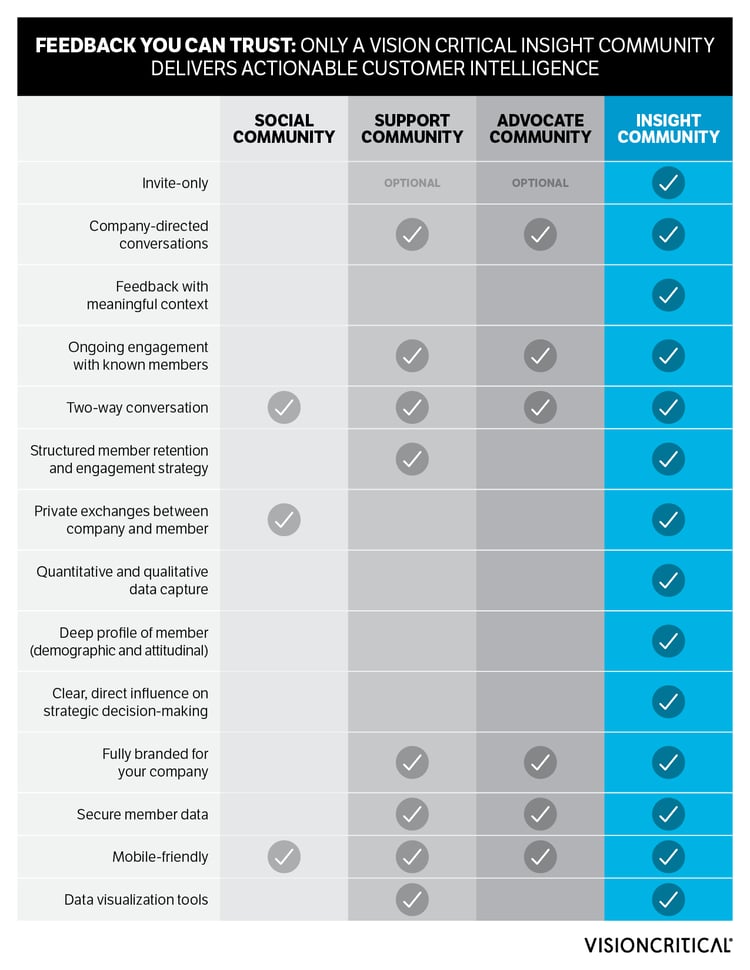Online communities are now mainstream business tools. A recent report from the analyst firm Demand Metric shows that two-thirds of companies employ different types of online communities. Larger enterprises are more likely to have communities, with 74 percent indicating that they have one.
What is an online community?
Insight communities are private, digital communities created and managed by a brand, versus public social media platforms that anyone can join (and where they might adopt any persona they choose). They’re safe spaces where customers feel free to share honest opinions, knowing your brand will listen and value their feedback. Because companies know who they’re interacting with, they can connect in meaningful ways to understand their customers’ needs and motivations.
You can think of insight communities in the same way as customer advisory boards, research panels, and focus groups, but with an important difference. In an insight community, members agree to participate on an ongoing basis, which means you can have two-way conversations and build a detailed profile of each participant. In this way, insight communities become more valuable to brands over time, as member profiles constantly become richer and more intricate.
Insight communities make those all-important customer relationships both intimate and scalable. They can be quite large, from hundreds to hundreds of thousands of members, allowing a brand to target queries to specific groups of customers and segment community members with ease and precision.
Given the ubiquity of online communities, the question many companies are asking is whether they have the right ones in place. Here's a look at the four different types of communities, the main advantages of each and our recommendations on how to get the most out of them.
Examples & Benefits of the Types of Online Communities
There are four different types of online communities:
1. Social communities include public social networks like Facebook, Twitter and Instagram. Brands use social communities mostly for marketing purposes, broadcasting information, building brand awareness and reaching greater audiences for campaigns and messaging. Social communities are useful for tracking what your competitors are up to and identifying broad consumer trends. Ninety-three percent of large companies use Facebook, according to a 2015 Social Media Examiner report.
Build Brand Affinity with Alida
2. Support communities enable members to offer product tips to other customers, helping companies reduce customer support costs. Compared to social communities, this category provides a more structured way of gathering innovative ideas because support communities allow brands to track product- and service-related conversations. According to a 2015 Forrester Research report, 81 percent of companies have a support community of some kind.
Innovate Faster Using Product Insights with Alida
3. Advocate communities allow brands to mobilize their most passionate, loyal customers. Also known as advocate marketing software, this community type often rewards members for writing a testimonial, posting about the company on social media and doing other similar activities. According to Laura Ramos, principal analyst at Forrester Research, branded customer communities of this type can help boost positive word of mouth.
4. Insight communities are made up of carefully selected groups of customers who maintain a long-term relationship with brands. These communities allow companies to gather continuous, high-quality feedback from engaged stakeholders like customers, partners or employees. Already a mainstream market research tool, this category is quickly finding its way in marketing, customer experience and innovation.
Improve Customer Experience With Alida
Best Practices for Selecting an Online Community Type
Each kind of community offers a unique set of business benefits. When deciding which type best suits your business needs, consider the following three steps:
1. Determine your business goal.
To get the most out of online communities, business leaders need to understand the problems they’re trying to solve. Consider the main purpose of your online community.
- Is it to provide an early-warning system about unhappy customers?
- Does it offer a chance to improve brand recognition?
- Do you need to test the viability of ideas and new products?
- Do you want to build customer loyalty?
Some community types are better suited for certain business challenges. Start by determining the business needs you require before talking to community software vendors.
2. Consider the depth of customer feedback you need.
Online communities allow companies to engage customers and gain insight into people’s attitudes and behaviors. Depending on the type of insight you want to gain, however, some categories are more useful than others.
For instance, companies often know very little about the people who belong to social communities. That’s because social networks tend to be dominated by a small but loud minority. The data you get from social media analytics doesn’t provide a complete picture of customer preferences and attitudes.
On the other hand, because customers go to support communities to find solutions to product problems, this category is a potential source of innovation insight. But support communities aren’t optimized for two-way conversations between the company and its customers. And because of that, support communities don’t enable companies to dig deeper on business issues.
Similarly, advocate communities aren’t designed for customer insight; most communities in this category lack robust features for quantitative and qualitative data capture.
"The opt-in nature of insight communities means members are more likely to participate often."
Insight communities, on the other hand, do allow brands to gather deep customer intelligence. Members agree to participate on an ongoing basis, so companies that use insight communities can get reliable feedback from a group of highly engaged customers. The opt-in nature of insight communities means members are more likely to participate often, allowing companies to build a detailed profile of each customer over time.
3. Choose the right, complementary mix of online communities.
Different online community types accomplish different business goals, so you may need more than one type. In fact, most companies do. This checklist is useful in determining what each type of community can and cannot deliver to your brand.

In general, enterprise companies need software in all categories of online communities to remain competitive in all aspects of the business. Ignoring one type of community could result in gaps in your customer intelligence or marketing strategy.
Don’t Put All Online Communities in One Bucket
The online community space is growing because companies recognize the need to engage customers, employees and other stakeholders in ongoing, two-way conversations. Thinking of online communities as one monolithic category limits their effectiveness.
Map your business needs to the different types of communities available at your disposal in order to derive the ROI you’re looking for from these important business tools.








